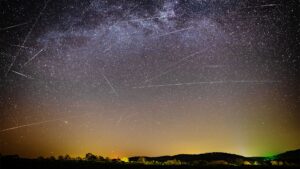GS3 – Science & Technology

Context:
The Lyrid meteor shower is expected to reach its peak in the early hours of April 22, with Indian observers potentially witnessing up to 20 meteors per hour between 3:00 AM and 5:00 AM under clear, dark skies — no telescopes required.
About the Lyrid Meteor Shower
Origin and Cause:
- The Lyrids are associated with Comet C/1861 G1 (Thatcher), a long-period comet that completes an orbit approximately every 415 years.
- As the comet orbits the Sun, it leaves behind a trail of dust and rocky fragments.
- Earth passes through this debris field annually in mid-to-late April, causing these particles to enter our atmosphere at high speed.
- The friction with Earth’s atmosphere causes the particles to burn up, creating bright streaks of light known as meteors or “shooting stars.”
Key Characteristics
- Point of Origin (Radiant): Appears to originate from the constellation Lyra, near the star Vega.
- Best Visibility:
- Most prominent in the Northern Hemisphere.
- While countries at higher latitudes like Russia experience optimal visibility, India also offers favorable viewing conditions.
- In the Southern Hemisphere, visibility is more limited due to the radiant’s lower position in the sky.
- Speed and Appearance:
- Enters the atmosphere at around 49 km/s.
- Despite being typically grain-sized, Lyrids can produce bright fireballs and lingering trails, also known as trains.
Unique Features
- Activity Rate: Normally yields about 10–20 meteors per hour, but is known for occasional unexpected bursts — such as the 1982 outburst, when the rate spiked to 90 meteors/hour.
- Duration of Peak: The Lyrids have a brief and intense peak period, unlike some meteor showers which have a more extended window of visibility.
- Scientific Significance: Their unpredictability and potential for sudden surges make them particularly interesting for scientific observation and study.




